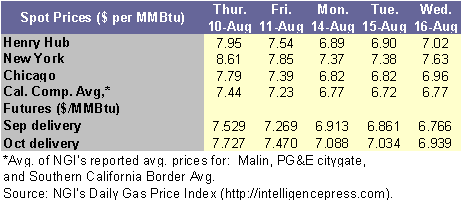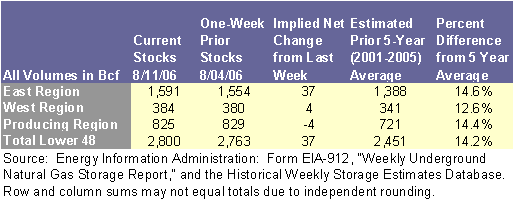

Overview: Thursday,
August 17 (next release 2:00 p.m. on August 24, 2006)
Since
Wednesday, August 9, natural gas spot prices decreased at most market locations
in the Lower 48 States. On Wednesday,
August 16, prices at the Henry Hub averaged $7.02 per MMBtu, decreasing 57
cents per MMBtu, or about 7.5 percent, since the previous Wednesday. The NYMEX futures contract for September
delivery at the Henry Hub settled at $6.766 per MMBtu, on Wednesday, August 16,
falling about 89 cents per MMBtu, or 11.6 percent, from the settlement price of
$7.651 last Wednesday, August 9. Natural
gas in storage was 2,800 Bcf as of August 11, which is about 14 percent above
the 5-year average. The spot price for
West Texas Intermediate (WTI) crude oil decreased $4.46 per barrel, or about 6
percent, on the week (Wednesday-Wednesday) to $71.64 per barrel or $12.35 per
MMBtu.
Spot prices fell since last Wednesday, August 9, with decreases ranging between 30 and 84 cents per MMBtu at most market locations. Decreased cooling load resulting from moderating temperatures and falling crude oil prices likely contributed to the price declines. Prices rallied through the middle of last week at most market locations, peaking on Thursday, August 10, but declined significantly thereafter with the bulk of the decreases occurring in trading Friday, August 11, and Monday, August 14. The largest price decreases since last Wednesday, August 9, occurred principally east of the Rocky Mountains, where prices fell more than 40 cents per MMBtu at most market locations. Meanwhile, prices west of the Rocky Mountains region fell between 30 and 45 cents per MMBtu at most market locations. Since August 1, when natural gas spot prices peaked this summer at most market locations, prices have fallen about $1 to $2 per MMBtu, or about 13 to 25 percent. Prices are also down relative to last year’s level at this time, with prices at the Henry Hub about $2.67 per MMBtu or about 28 percent below last year’s level. This year’s lower price level reflects an improved natural gas supply situation relative to last year owing in part to the absence of hurricane activity in the Gulf of Mexico this year. In contrast, by this time last year five tropical storms, including three hurricanes, had threatened production in the Gulf of Mexico. Another factor contributing to the lower price level this year relative to last year is the level of working gas in storage, which remains significantly above the 5-year average and last year’s level at this time. This likely is mitigating injection demand for natural gas.

At
the NYMEX, prices for the futures contracts for the next 12 months fell across
the board with the 12-month futures strip (September 2006 through August 2007)
posting a decline of about 47 cents per MMBtu, or about 5 percent, since last
Wednesday, August 9. Prices for the futures contracts for delivery at the Henry
Hub in September and October decreased, falling about 89 and 92 cents per
MMBtu, respectively, since the previous Wednesday. Prices for the futures contracts for delivery
during the heating season months (November 2006 through March 2007) decreased
by about 4 percent since last Wednesday, August 9. Averaging $10.485 per MMBtu, the futures
contract prices for delivery during the upcoming heating season traded at a
premium of about $3.47 per MMBtu to the Henry Hub spot price. Overall, the 12-month futures strip
(September 2006 through August 2007) traded at a premium of $2.02 per MMBtu
relative to the Henry Hub spot price, averaging $9.04 per MMBtu as of
Wednesday, August 16. Differentials of
this magnitude between the spot price and the futures contract prices provide
suppliers strong economic incentives to inject gas into storage.
Recent Natural Gas Market Data
|
Estimated Average Wellhead Prices |
||||||
|
|
Feb-06 |
Mar-06 |
Apr-06 |
May-06 |
June-06 |
July-06 |
|
7.28 |
6.52 |
6.59 |
6.19 |
5.80 |
5.82 |
|
|
Price
($ per MMBtu) |
7.09 |
6.35 |
6.42 |
6.03 |
5.65 |
5.67 |
|
Note:
Prices were converted from $ per Mcf to $ per MMBtu using an average heat
content of 1,027 Btu per cubic foot as published in Table A4 of the Annual
Energy Review 2002. |
||||||
|
Source: Energy Information Administration, Office
of Oil and Gas. |
||||||
Working
gas in storage totaled 2,800 Bcf as of Friday, August
11, which is about 14 percent above the 5-year average inventory level for the
report week, according to EIA’s Weekly Natural Gas Storage Report (See Storage Figure).
During the week, the implied net injection of 37 Bcf
was 40 percent less than the 5-year average of 62 Bcf
and 27 percent below last year’s injection of 51 Bcf.
As of August 11, stocks exceeded last year’s level by 292 Bcf
and the 5-year average by 349 Bcf. Since May 12, when the difference
between working gas stocks and the 5-year average peaked at 722 Bcf, this
difference has declined each week with 213 Bcf of the total decline of 373 in
this difference occurring during the last 4 weeks. During the report week, temperatures in the
Lower 48 States were warmer than normal with cooling degree days (CDD) exceeding
normal levels in each of the nine Census Divisions of the Lower 48 States. CDDs were 30 percent or more above normal in
the West North Central and East South Central Census Divisions. CDDs in all other Census Divisions except
New England and the Pacific were 14 percent or more above normal for this time
of year. Overall, cooling degree days
were. about 17 percent above normal on average in the Lower 48 States. (See
Temperature Maps)

Other Market Trends:
Office of Fossil Energy and EIA Seek
Comment on Import/Export Program: The
Department of Energy’s Office of Fossil Energy (FE) and the EIA are soliciting
public comments on a proposed change to FE’s data collection program regarding
imports and exports of natural gas, including liquefied natural gas. According
to a Federal Register notice released on August 10, FE is proposing to
collect information on imports and exports only on a monthly basis. Currently,
FE collects the information on a monthly and quarterly basis. The proposed
change still would allow FE to collect all of the current detailed information,
including country of origin, destination, international point of entry/exit,
pricing, transporter, purchaser, market served, and contract term on a monthly
basis. The notice includes a request for input on the usefulness of the
information, what enhancements could be made, details on the reporting burden
and the costs of providing the information. Comments on the proposed change
should be sent to Yvonne Caudillo at yvonne.caudillo@hq.doe.gov or by fax to
(202) 586-6050.
MMS Holds Lease Sale
for Western Gulf of Mexico Tracts: The Western Gulf of Mexico Lease Sale 200 conducted by the
Minerals Management Service (MMS) on August 16 garnered $340.9 million in high
bids from 62 companies for oil and natural gas leases in the Federal waters of
the Gulf of Mexico. The total of all bids was $462.7 million, a 38 percent
increase over last year’s Western Gulf Sale.
The agency received 541 bids on 381 tracts. Sale 200 is the leading Western Sale in terms
of number of bids submitted in the past 9 years, and the highest in 8 years for
the amount of money bid. In this sale,
3,865 blocks comprising approximately 20.87 million acres offshore Texas and
the deeper waters offshore Louisiana were offered. Interest in deepwater
oil and gas production continues to grow, with 67 percent of all tracts
receiving bids in water depths of greater than 400 meters. Bidding activity was
led by interest in the Garden Banks and Keathley Canyon areas. In all, more
than 50 percent of the tracts receiving bids in the sale were in these two
areas. The top bidders in the sale
included BP Exploration and Production, Inc. and Petrobras America Inc. BP submitted
the highest bid, $21.0 million, for Keathley Canyon Block 58. Petrobras America
Inc., submitted the second highest bid, $12.8 million, which went for Keathley
Canyon Block 59. The high bids on each block will go through an evaluation
process to ensure the public receives fair market value before a lease is
awarded.
Natural Gas
Transportation Update: